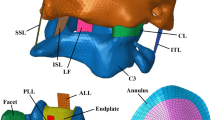Abstract
A three-dimensional non-linear poroelastic finite element model of an L3/L4 motion segment was used to analyze the biomechanical effects of degeneration under impact loading on the spinal segment. A previously developed degeneration algorithm was applied to generate a degenerated disc model. Regional variation in intact vertebral body bone morphology was simulated by assigning different void ratios of 4.0–5.02, which were assessed for 27 regions of vertebral cancellous bone. For the osteoporotic structure of the vertebral body, the body was divided into 5 regions with 10–24 void ratios. Different material properties were assigned to the annulus fibers; hereupon our annulus model reflected variation in tensile behavior of multiple layer annulus samples. The impact load applied to the top of the L3 vertebral body was assumed to be a triangular impulsive force with a maximum compressive impact load of 3 kN and 20ms impact duration time. Calculated results indicated that the effect of the degeneration was predominant at the center of the vertebral body. The maximum von Mises stress was found at the region of near the endplate. The degeneration increased the averaged stress at the center of the vertebral body of L3 from 1.54 MPa to 1.69 MPa, the stress remaining relatively small at L4. Decreased fluid volume ratio of the degenerated nucleus tended to increase pressure slightly at the nucleus, and the averaged stress at the nucleus was almost doubled compared to the intact case. The innermost layers of the anterior annulus showed the highest stress concentration, followed by outermost anterior and posterior regions, for both the degenerated and the intact models. Despite an irregular stress distribution in the degenerated model, pore pressure showed relatively uniform distribution.
Similar content being viewed by others
References
A. A. White and M. M. Panjabi, Clinical Biomechanics of the Spine, Lippincott Williams and Wilkins, Philadelphia (1990).
J. Willen, S. Lindahl, L. Irstam, B. Aldman and A. Nordwall, The thoracolumbar crush fracture. An experimental study on instant axial dynamic loading: The resulting fracture type and its stability, Spine, 19 (1984) 624–631.
N. T. Tran, N. A. Watson, A. F. Tencer, R. P. Ching and P. A. Anderson, Mechanism of the burst fracture in the thoracolumbar spine, Spine, 20 (1995) 1984–1988.
M. M. Panjabi, S. Ito, A. M. Pearson and P. C. Ivancic, Injury mechanisms of the cervical intervertebral disc during simulated whiplash, Spine, 29 (2004) 1217–1225.
C. J. Colloca, T. S. Keller, R. J. Moore and R. Gunzburg, Intervertebral disc degeneration reduces vertebral motion responses, Spine, 32 (2007) E544–550.
B. R. Simon, J. S. S. Wu, M. W. Carlton, L. E. Kazarian, E. P. France, J. H. Evans, and O. C. Zienkiewicz, Poroelastic Dynamic Structural Models of Rhesus Spinal Motion Segments, Spine, 10 (1985) 494–507.
C. K. Lee, Y. E. Kim, C. S. Lee, Y. M. Hong, J. M. Jung and V. K. Goel, Impact response of the intervertebral disc in a finite-element model, Spine, 25 (2000) 2431–2439.
Y. E. Kim, S. Y. Cho and H. Y. Choi, Anaysis of dural-sac occulusion in a lumbar spinal motion segement FE model, J. of Musculoskeletal Research, 5 (2001) 243–252.
S. Ebara, J. C. Iatrisdis, L. A. Setton, R. J. Foster, V. C. Mow and M. Weidenbaum, Tensile properties of nondegenerate human lumbar annulus fibrosus, Spine, 21 (1996) 452–461.
J. D. Kraemer, M. Kolditz and R. Gowin, Water and electrolyte content of human intervertebral discs under variable load, Spine, 10 (1985) 69–71.
D. G. Woo, Y. E Kim, S. T. Kim and H. S. Kim, Simulation of the disc degeneration with a poroelastic finite element model, J. of Mechanical Science and Technology, 21 (2007) 1178–1183.
G. A. Holzapfel, C. A. Schulze-Bauer, G. Feigl and P. Regitnig, Single lamellar mechanics of the human lumbar annulus fibrosus, Biomech. Model Mechanobiol. 3 (2005) 125–140.
J. C. Lotz, O. K. Colliou, J. R. Chin, N. A. Ducan and E. Liebenberg, Compression-induced degeneration of the intervertebral disc; An in vivo mouse model and finite element study, Spine, 23 (1998) 2493–2506.
H. Schmidt, A. Kettler, A. Rohlmann, L. Cleas and H. J. Wilke, The risk of disc prolapses with complex loading in different degrees of disc degeneration a finite element analysis, Clinical Biomechanics, 22 (2007) 988–998.
M. Miura, M. M. Panjabi, T. R. Oxland, J. J. Crisco, I. Yamamoto and A. Vasavada, Disc degeneration affects the multidirectional flxibity of the lumbar spine, Spine, 19 (1994) 1371–1380.
M. Adams, N. Bogduk, K. Burton and P. Dolan, The Biomechanics of Back Pain, Churchhill, Livingston (2002).
Author information
Authors and Affiliations
Corresponding author
Additional information
This paper was recommended for publication in revised form by Associate Editor Young Eun Kim
YoungEun Kim received a B.S. degree in Mechanics and Design from Seoul National University in 1978. He then went on to receive his M.S. from KAIST in 1986 and Ph.D. degrees from U. of Iowa 1988. Dr. Kim is currently a Professor at the Dept. of Mechanical Engineering at Dankook University in Yongin, Korea. He is currently serving as an Editor of the Open Orthopedic Research Journal. He was also served as a division chair of KSPE. Dr. Kim’s research interests are in the area of biomechanics, and occupant dynamics.
Rights and permissions
About this article
Cite this article
Kim, Y., Choi, H. Analysis of the impact responses in a degenerated spinal motion segment FE model. J Mech Sci Technol 23, 19–25 (2009). https://doi.org/10.1007/s12206-008-0923-6
Received:
Revised:
Accepted:
Published:
Issue Date:
DOI: https://doi.org/10.1007/s12206-008-0923-6




